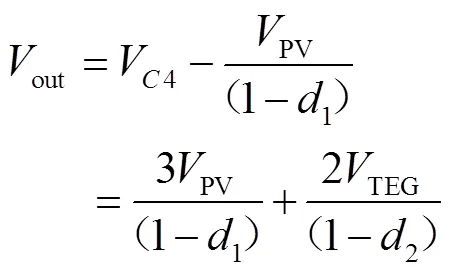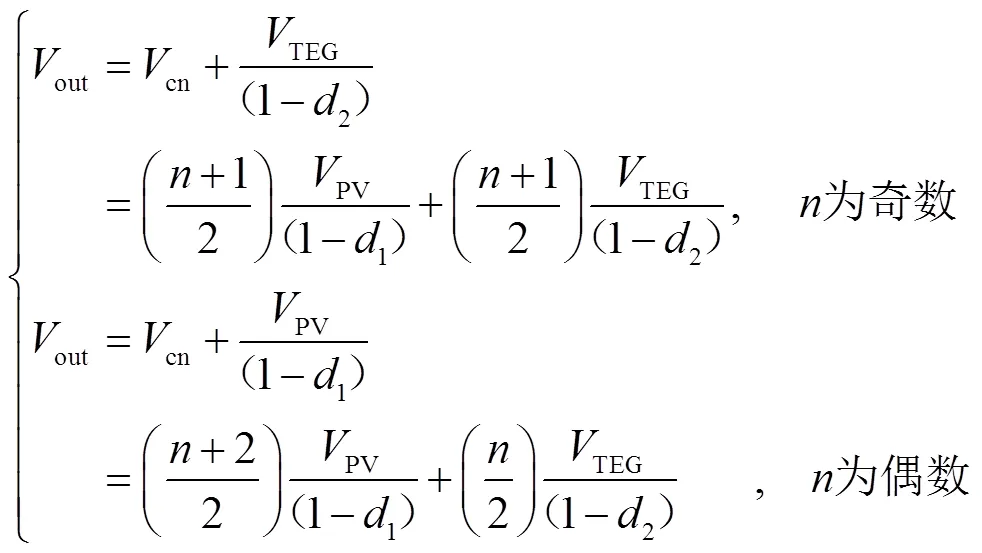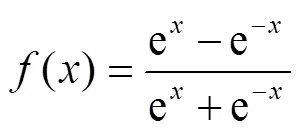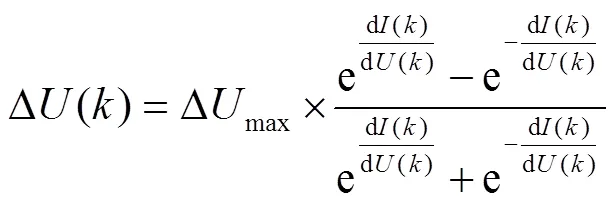基于双曲正切函数的光伏/温差自适应MPPT控制策略研究
王立舒,白 龙,2,房俊龙,李欣然,李 闯,董宇擎
基于双曲正切函数的光伏/温差自适应MPPT控制策略研究
王立舒1,白 龙1,2,房俊龙1※,李欣然1,李 闯1,董宇擎1
(1. 东北农业大学电气与信息学院,哈尔滨 150030;2. 牡丹江师范学院物理与电子工程学院,牡丹江 157011)
为了提高光伏/温差联合发电系统的效率,需要进行最大功率点跟踪(Maximum Power Point Tracking,MPPT)控制。针对传统电导增量法步长固定不变导致跟踪速度慢和稳态误差大的缺点,该研究提出一种恒定电压法和双曲正切型自适应变步长算法结合的MPPT控制策略。该策略利用双曲正切函数单调递增、变化速度快的特点,使步长可以根据光强等外界环境条件的变化,自适应地快速调整,同时利用恒定电压法加快追踪的响应速度。Matlab/Simulink软件仿真和硬件试验表明,该研究所提方法在光照强度剧烈变化时,系统能够在15 ms内快速跟踪到最大功率点,同时稳态误差低于0.3%,实现了MPPT控制在跟踪速度和稳态精度方面的同步优化。
光伏;温差;自适应;双曲正切函数;MPPT
0 引 言
随着温室内传感器等装置的增多,传统供电方式安装复杂、维护不便、性价比低的弊端日益显现,环保、便捷的太阳能逐渐受到人们重视[1-3]。但是光伏电池的发电效率会随着工作温度的升高而大幅降低[4-6],为了解决这个问题,Vorobiev等[7]提出了光伏/温差联合发电技术,将光伏电池产生的多余热量作为温差发电系统的热源,实现二次发电,从而提高整个系统的发电效率。然而在实际使用中,需要光伏/温差联合发电系统尽可能工作在最大功率点,使系统发挥最大潜力。
目前,常用的MPPT算法包括恒定电压法[8](Constant Voltage Tracking,CVT)、扰动观察法[9](Perturbation and Observation Method,P&O)和电导增量法[10-11](Incremental Conductance,INC)等,此外,一些智能启发式算法也被应用到最大功率点跟踪控制之中,例如:模糊控制[12]、人工神经网络[13]、粒子群算法[14]等。其中,电导增量法原理简单、实现容易,但该方法有着比较明显的缺陷,即采用固定步长,选择不当会导致算法无法及时找到最大功率点或发生振荡。针对这个问题,文献[15]将粒子群算法与电导增量法相结合,首先利用粒子群算法预测最大功率点附近电压和电流,然后利用电导增量法根据这两个值来寻找最大功率点,取得较好的跟踪效果。但该方法计算复杂度较高,需要较高的硬件代价;文献[16]将恒定电压法和电导增量法相结合,在起始阶段利用恒定电压法快速定位到最大功率点附近,然后利用电导增量法寻找最大功率点,并通过改变比例因子使步长可以动态变化。但是该方法仅仅只是利用传统电导增量法中的步长最大值对比例因子进行简单限制,并没有真正实现自适应;文献[17]采取了同样的控制策略,不同的是比例因子采用试凑法给定,该方法的灵活性和鲁棒性较差;文献[18]提出一种可根据外界环境变化自动调整步长的自适应电导增量法,采用了一种新的步长调整系数,提高了算法的响应速度。但该方法的实质与文献[16]和文献[17]相同,只是步长调整因子的形式略有些变化,仍然无法做到真正意义上的自适应。
基于上述分析,为了更好的实现光伏/温差联合发电系统的最大功率点跟踪控制,本文提出一种自适应变步长电导增量算法与恒定电压法结合的控制策略。该方法利用双曲正切函数的特性,使电导增量法的步长可以真正实现自适应变化,有效提高了算法的跟踪速度和稳态特性。并通过实验证明了该方法的正确性和有效性。
1 系统结构
光伏/温差联合发电系统中,光伏电池与温差发电片相连,电池内多余的热量与冷却系统构成一个温差装置,使温差发电片持续产生电能,从而实现了对太阳能的二次利用,提高系统的输出效率。光伏/温差联合发电系统的结构如图1所示,主要包括:槽式抛物线形聚光器,三角形热管[19-21](两侧由内向外依次为温差发电片组和光伏电池)、热交换器、流量计、可调水泵、MPPT控制器、数据采集卡、双输入DC-DC变换器(如图1b所示)和负载等。如图1a所示,太阳光经抛物型聚光器反射到光伏电池上,被光伏电池吸收的光能一部分转换为电能,另一部分转换成热能传递给温差发电片组的热端,温差发电片组的冷端经热管中的水冷却,形成温差发电。
如图1b所示,双输入DC-DC变换器电路中,二极管和电容组成电压倍增器(VM级)与2个升压级集成在输入端。VM级用于帮助升压级实现更高的整体电压增益。电压转换比率取决于VM级的数目和输入升压级的开关占空比。图1b显示了所提出的具有4个VM阶段的转换器。为了简单和更好的理解,这里解释具有4个乘法器阶段的变换器的操作。类似分析可以扩展到级变换器。
当通过VM级给电容器充电时,电荷逐渐从输入转移到输出,1两端电源可近似为0。

电容1和2两端电压如公式(2)和(3)。


式中1和2分别为场效应管1和2的开关占空比,V3和V4为电容1和2两端电压,V。由式(2)和式(3)可得四VM级变换器的电容器电压如公式(4)所示。
由式(2)可得输出电压如公式(5)所示。

类似分析可以推广到具有个VM 级的变换器,因此VM级电容器电压如公式(6)所示。

具有个VM级变换器的输出电压方程如公式(7)所示。

2 自适应变步长MPPT控制
电导增量法诞生之初,由于算法性能非常依赖于电压和电流检测的精度和速度[22-24],因此使用的较少。但是随着微电子、集成电路以及传感技术的飞速发展,高速、高精度数模转换器和高性能DSP等大量出现,使得电导增量法的推广使用成为可能[25-27]。
2.1 电导增量法的基本原理



如果为情况②,则

2.2 自适应变步长电导增量法

定义如下的双曲正切型函数:

其特性曲线如图3所示。

如此一来,在系统输出功率远离最大功率点时,几乎以最大步长进行调整;而当输出功率接近最大功率点时,又能快速减小步长。同时追踪启动时,利用恒定电压法快速定位到最大功率点附近,从而使系统的跟踪特性和稳态误差同时取得较好效果。结合了恒定电压法的自适应变步长电导增量法的实现流程如图4所示。
3 试验分析
3.1 仿真试验分析
为了检验本文所提自适应变步长电导增量法在光伏/温差联合发电系统最大功率点跟踪控制中的性能,利用Matlab/Simulink软件平台组建仿真模型,对算法进行仿真试验,并从首次跟踪到最大功率点所需时间(启动时间)、环境(辐照度)剧烈变化时再次跟踪到最大功率点所需时间、系统输出功率的平均值和稳态误差等方面进行算法优劣性分析。光伏/温差发电部分仿真结构如图 5所示,本文采用的光伏电池仿真模型为晶澳公司的JAMG-6-60-250/SI型光伏组件,其部分主要参数如表1所示。温差发电片仿真模型为星河公司的F40550,其部分主要参数如表2所示[28]。

表2 温差发电片主要参数

由图6可知,本文所提变步长电导增量法的跟踪性能最佳。对于固定步长电导增量法,光照突然升高时,小步长和大步长的系统调节时间分别为46.3和24.2 ms;光照突然降低时,系统调节时间分别为34.8和13.5 ms;光照强度在1 000 W/m2稳定时,系统平均输出功率分别为317.4和324.7 W。由此可见,当步长较大时,算法的启动速度和动态响应时间明显较好,但相应的稳态误差较大,输出功率振荡明显,导致系统的整体效率降低。文献[18]算法的性能要明显好于固定步长电导增量法。该方法使步长具有一定的自适应能力,光照突变时系统调节时间分别为22.7和23.1 ms,光照强度为1 000 W/m2时,系统平均输出功率为317.8 W,可见算法对系统的跟踪速度和稳态精度都有一定程度的改善。
本文所提变步长电导增量法在光照突变时的调节时间分别为12.5和12.1 ms,系统平均输出功率在光照强度为1 000 W/m2时保持在316.4 W左右,无论相比较与固定电导增量法还是文献[18]的变步长电导增量法,系统跟踪速度和稳态精度都有很大程度的提高。这主要由于本文算法令步长按照双曲正切形式连续变化,使算法真正实现了快速、自适应跟踪实际的最大功率点,因此算法的性能最优。
为了更为具体的比较本文算法和文献[18]算法的优劣,将光照变化时算法步长的变化情况给出,如图7所示。可以明显看出,无论是光照强度突然升高还是突然降低,文献[18]算法的步长变化都较为凌乱,步长时大时小,没有向着一个方向连续变化,说明调节过程中存在调节过大的情况,而且即使系统输出稳定后,也时而存在步长不为0的情形。而本文算法在光照突然升高和降低时,步长变化趋势一致,调节迅速,在系统输出功率稳定后步长一直保持为0,非常好的实现了最大功率点跟踪控制。
3.2 硬件试验
2020年10月,在东北农业大学进行了最大功率点跟踪试验,试验装置如图8所示。控制器采用的是TI公司的TMS320LF2407A。JXBS-3001-ZFS太阳辐射传感器测量辐照度,测量范围0~1 500 W/m2,RS485输出。PZEM-031直流多功能表测量输出电压与输出电流,计量精度1.0级,电压测量范围6.5~100 V,电流测量范围0~20 A。负载为阻值150 Ω的大功率电阻。多晶硅光伏电池尺寸制定为700 mm×60 mm×2.3 mm,开路电压4.44 V,短路电流1.81 A,温差发电部分采用14个型号为SP1848-27145的温差发电片进行串联,并根据变步长电导增量法控制策略产生相应的PWM实现MPPT控制。为了验证本文算法具有较强的实用性,能够适应不同的环境条件,因而选择光照度和温度逐渐增强和基本不变的2个时间段[29-30]A(8:00~9:00)、B(12:00~13:00)进行电压和电流的数据采集以及跟踪试验,分别在A、B两个时间段的第1 min、第31 min和第60 min,每隔1 ms采集一个电压电流数据,将采集到的数据进行功率计算,并计算结果的平均值,试验测得结果如表3所示。2个时间段本文自适应电导增量法首次跟踪到最大功率点所用的时间分别为13.8和13.4 ms;平均输出功率为71.5和96.58 W,与系统理论输出功率相差7%左右,主要因为试验采用的多晶硅电池纯度不高,测量仪器存在一定的误差导致。但试验结果趋势与仿真结果基本相符,能够达到提高跟踪速度与系统稳定同步优化的目的。可以看出,利用本文算法进行MPPT控制后,当光照强度变化时,步长变化趋势一致,功率输出波动更小,调节速度快,自适应性好,系统可在15 ms内快速追踪并稳定在最大功率点,且系统稳态误差低于0.3%。

1.抛物型聚光器 2.光伏温差混合发电系统 3.辐照度测试仪 4.DC-DC变换器 5.数据采集卡 6.负载 7.USB转485模块 8.直流多功能表 9.计算机 10.DSP

表3 硬件试验数据对比
4 结 论
本文重点研究光伏/温差联合发电系统的最大功率点跟踪控制。针对传统电导增量法步长固定选取的缺点,提出了一种采用双曲正切形式渐变步长的自适应步长电导增量法与恒定电压法相结合的控制策略。并分别进行了仿真和硬件试验,由试验结果可得到以下结论:
1)相比于传统固定步长电导增量法,本文提出的自适应变步长电导增量法可以有效降低系统启动时间,在光照突变时,系统可以在15 ms内快速追踪到最大功率点,响应速度明显提升;
2)本文提出的自适应变步长电导增量法在系统动态跟踪速度和稳态精度之间取得了很好的平衡,系统响应速度提高的同时,稳态误差低于0.3%,系统稳定性更优;
3)本文采用的双曲正切型步长变化规律,能够使步长快速、自适应变化,从而使系统输出可以快速跟踪最大功率点。算法原理简单,硬件消耗小,非常适宜在DSP、FPGA等硬件上实现,可以较快的应用于实践之中。
[1] 杨亚林,朱德兰,李丹,等. 积灰和光照强度对光伏组件输出功率的影响[J]. 农业工程学报,2019,35(5):203-211.
Yang Yalin, Zhu Delan, Li Dan, et al. Influence of dust accumulation and light intensity on output power of photovoltaic modules[J]. Transactions of the Chinese Society of Agricultural Engineering (Transactions of the CSAE), 2019, 35(5): 203-211. (in Chinese with English abstract)
[2] 刘天扬. 兆瓦级光伏电站并网电压控制技术研究[D]. 南京:东南大学,2019.
Liu Tianyang. Research on the Voltage Control in Grid-connect Megawatt-class Photovoltaic Power Station[D]. Nanjing: Southeast University, 2019. (in Chinese with English abstract)
[3] 李欣然,王立舒,李闯,等. 光伏温差界面热耦合特性及混合发电效率[J]. 农业工程学报,2021,37(1):233-240.
Li Xinran, Wang Lishu, Li Chuang, et al. Thermal coupling characteristics of photovoltaic-thermoelectric interface and efficiencyof hybrid power generation[J]. Transactions of the Chinese Society of Agricultural Engineering (Transactions of the CSAE), 2021, 37(1): 233-240. (in Chinese with English abstract)
[4] 汤允凤. 太阳能光伏光热综合利用系统研究及优化控制[D]. 南宁:广西大学,2019.
Tang Yunfeng. Research and Optimal Control of Solar Photovoltaic/thermal Comprehensive[D]. Nanning: Guangxi University, 2019. (in Chinese with English abstract)
[5] 刘畅,陈启卷,陈桂月,等. 光伏-燃料电池混合发电系统建模与仿真[J]. 太阳能学报,2018,39(11):3113-3119.
Liu Chang, Chen Qijuan, Chen Guiyue, et al. Modeling and simulation of PV-fuel cell hybrid power system[J]. Acta Energiae Solaris Sinica, 2018, 39(11): 3113-3119. (in Chinese with English abstract)
[6] 朱丽,陈萨如拉,杨洋,等. 太阳能光伏电池冷却散热技术研究进展[J]. 化工进展,2017,36(1):10-19.
Zhu Li, Chen Sarula, Yang Yang, et al. Research progress on heat dissipation technology of photovoltaic cells[J]. Chemical Industry and Engineering Progess, 2017, 36(1): 10-19. (in Chinese with English abstract)
[7] Vorobiev Y, Gonzalez H J, Vorobiev P, et al. Thermal-photovoltaic solar energy conversion[J]. Solar Energy, 2006, 80: 170-176.
[8] Jana J, Samanta H, Das Bhattacharya K, et al. Design and development of high efficiency five stagebattery charge controller with improved MPPT performance for solar PV systems[J]. International Journal of Renewable Energy Research, 2018, 8(2): 941-953.
[9] 徐凯,王湘萍. 光伏发电最大功率点跟踪的智能集成控制[J]. 太阳能学报,2018,39(2):536-543.
Xu Kai, Wang Xiangping. Intelligent integrated control for maximum powerpoint tracking of PV generation system[J]. Acta Energiae Solaris Sinica, 2018, 39(2): 536-543. (in Chinese with English abstract)
[10] 徐建国,沈建新,王海新. 基于新型变步长电导增量法的最大功率点跟踪策略[J]. 可再生能源,2018,36(9):1305-1313.
Xu Jianguo, Shen Jianxin, Wang Haixin, et al. Maxi-mum power point tracking strategy based on novel variable step-size incremental conductance algorithm[J]. Renewable Energy Resources, 2018, 36(9): 1305-1313. (in Chinese with English abstract)
[11] 卢超. 一种改进型电导增量法 MPPT 控制策略仿真研究[J]. 信息技术,2019(3):111-115.
Lu Chao. Simulation study of MPPT control strategy based on an improved conductance increment method[J]. Information Technology, 2019(3): 111-115. (in Chinese with English abstract)
[12] Mirza A F, Ling Q, Javed M Y, et al. Novel MPPT techniques for photovoltaic systems under uniform irradi-ance and Partial shading[J]. Solar Energy, 2019, 184: 628-648.
[13] Zhao Y, Li H, Liu L Q, et al. The MPPT control method by using BP Neural Networks in PV generating system[C]. 2011 2nd International Conference on Network Engineering and Computer Science. 2011, 9: 482-487.
[14] 徐珊珊,金玉华,张庆兵. 带全局判据的改进量子粒子群优化算法[J]. 系统工程与电子技术,2018,40(9):2131-2137.
Xu Shangshang, Jin Yuhua, Zhang Qingbing. Improved quantum-particle swarm optimization with global criterion[J]. Systems Engineering and Electronics, 2018, 40(9): 2131-2137. (in Chinese with English abstract)
[15] 翟小军,杜蘅,刘建义,等. 粒子群算法与电导增量法的双级最大功率点跟踪控制[J]. 红外与激光工程,2016,45(6):190-195.
Zhai Xiaojun, Du Xun, Liu Jianyi, et al. Two-stage maximum power point tracking control based on particle swarm optimization and conductance increment method[J]. Infrared and Laser Engineering, 2016,45(6): 190-195. (in Chinese with English abstract)
[16] 刘家赢,韩肖清,张鹏. 一种改进的变步长电导增量法在光伏MPPT中的应用[J]. 电气应用,2014,7:23-27.
Liu Jiaying, Han Xiaoqing, Zhang Peng. Application of an improved variable step size conductance increment method in photovoltaic MPPT[J]. Electrical Applications, 2014, 7: 23-27. (in Chinese with English abstract)
[17] 周建萍,朱建萍. 自适应变步长电导增量法的最大功率点跟踪控制[J]. 上海电力学院学报,2014,30(3):235-239.
Zhou Jianping, Zhu Jianping. Maximum power point tracking control of adaptive variable step size conductance increment method[J]. Journal of Shanghai Electric Power Institute, 2014, 30(3): 235-239. (in Chinese with English abstract)
[18] 周东宝,陈渊睿. 基于改进型变步长电导增量法的最大功率点跟踪策略[J]. 电网技术,2015,39(6):1491-1498.
Zhou Dongbao, Chen Yuanrui. Maximum power point tracking strategy based on improved variable step size conductance increment method[J]. Grid Technology, 2015, 39(6): 1491-1498. (in Chinese with English abstract)
[19] 王立舒,冯广焕,张旭,等. 聚光太阳能光伏/温差复合发电系统设计与性能测试[J]. 农业工程学报,2018,34(15):230-238.
Wang Lishu, Feng Guanghuan, Zhang Xu, et al. Design and performance test of concentrating solar photovoltaic / thermoelectric hybrid power generation system[J]. Transactions of the Chinese Society of Agricultural Engineering (Transactions of the CSAE), 2018, 34(15): 230-238. (in Chinese with English abstract)
[20] 梁秋艳. 聚光太阳能温差发电关键技术及热电性能机理研究[D]. 哈尔滨:东北农业大学,2016.
Liang Qiuyan. Research of Concentration Solar Thermoelectric Generation Key Technology and Thermoelectric Performance Mechanism[D]. Harbin: Northeast Agricultural University, 2016. (in Chinese with English abstract)
[21] 别玉,李明,陈飞,等. 基于槽式聚光集热的腔体吸收器热损失特性研究[J]. 太阳能学报,2017,38(2):423-430.
Bie Yu, Li Ming, Chen Fei, et al. Heat loss properties of cavity absorber in solar collecting system with parabolic trough concentrator[J]. Acta Energiae Solaris Sinica, 2017, 38(2): 423-430. (in Chinese with English abstract)
[22] 聂健. 太阳能光伏定向跟踪装置的设计与开发[D]. 长沙:湖南师范大学,2014.
Nie Jian. Design and Development of Solar Photovoltaic Directional Tracking Device[D]. Changsha: Hunan Normal University, 2014. (in Chinese with English abstract)
[23] 张政. 太阳能光伏光热一体化热泵/热管系统性能研究[D]. 南京:东南大学,2016.
Zhang Zheng. Performance Research of a Solar Photovoltaic/Thermal Integrated Heat Pump/Heat Pipe system[D]. Nanjing: Southest University, 2016. (in Chinese with English abstract)
[24] Huynh D C, Dunnigan M W. Development and comparison of an improved incremental conductance algorithm for tracking the MPP of a solar PV panel[J]. IEEE Transactions on Sustainable Energy, 2016, 7(4): 1421-1429.
[25] 梁亮,詹智民,邓小磊,等. 基于电导增量法的太阳能光伏阵列MPPT仿真[J]. 郑州大学学报,2018,39(6):88-92.
Liang Liang, Zhan Zhiming, Deng Xiaolei, et al. PV array mppt simulation based on the conductance increment method[J]. Journal of Zhengzhou University (Engineering Science), 2018, 39(6): 88-92. (in Chinese with English abstract)
[26] Mousa H, Youssef A, Mohamed E M. Variable step size P&O MPPT algorithm for opti-mal power extraction of multi-phase PMSG based windgeneration system[J]. Electrical Power and Energy Systems, 2019, 108: 218-231.
[27] Ahmed J, Salam Z. An improved perturb and observe(P&O) maximum power point tracking (MPPT) algo- rithm for higher efficiency[J]. Applied Energy, 2015, 150: 97-108.
[28] Hamidreza N, Keith A W. Modeling and analysis of a combined photovoltaic-thermoelectric power generation system[J]. Journal of Solar Energy Engineering, 2013, 135(031013): 1-8.
[29] 王立舒,王慧杰,赵嘉玮,等. 基于电导-模糊双模式的MPPT优化控制[J]. 太阳能学报,2017,38(7):1847-1853.
Wang Lishu, Wang Huijie, Zhao Jiawei, et al. Inc-fuzzy dual mode for optimal control of photovoltaic maximum power point[J]. Acta Energiae Solaris Sinica, 2017, 38(7): 1847-1853 (in Chinese with English abstract)
[30] 刘伟,张健,金宏达,等. 哈尔滨地区辐照度推算及NASA数据适用性分析[J]. 黑龙江电力,2019,41(2):179-183.
Liu Wei, Zhang Jian, Jin Hongda, et al. Estimation of irradiance and applicability analysis of NASA data in Harbin[J]. Heilongjiang Electric Power. 2019,41(2):179-183. (in Chinese with English abstract)
Self-adaptive photovoltaic/temperature difference MPPT control strategy based on hyperbolic tangent function
Wang Lishu1, Bai Long1,2, Fang Junlong1※, Li Xinran1, Li Chuang1, Dong Yuqing1
(1.,,150030,; 2.,,157011,)
An effective supply mode, solar power is gradually gaining much attention for the environmental friendliness and convenience. Among them, a photovoltaic/thermal co-generation technology is usually utilized to improve the power generation efficiency of photovoltaic cells, as the operating temperature rises. As such, the redundant heat generated by the photovoltaic cells was reused as the heat source for the temperature difference of the power generation system to realize secondary power generation. Moreover, the Maximum Power Point Tracking (MPPT) control is also required to achieve the optimal potential of the co-generation system. In this study, a new MPPT control of photovoltaic/temperature difference was proposed further to combine the constant voltage and hyperbolic tangent type adaptive variable step size, in response to the oscillation and misjudgment caused by the fixed step size of traditional conductance increment. Two advantages were included here: First, the control was the fast tracking to the area near the nonlinear region of the maximum power point using 0.78 times of the system open-circuit voltage, suitable for the great changing environmental conditions. Second, the step size was adjusted adaptively and quickly, according to the change of external environmental conditions, when the MPPT was tracking to the nonlinear region near the maximum power points. For instance, the light intensity was used to reduce the system oscillation, indicating the monotonic increase and fast variation in the hyperbolic tangent function. Furthermore, a simulation model was established to evaluate the performance of adaptive variable step conductance increment in the MPPT control of a combined photovoltaic/thermal power generation system using the Matlab/Simulink software. Specifically, Jinao JAMG-6-60-250/SI photovoltaic module was set as the photovoltaic cell model, and Xinghe F40550 was the thermoelectric chip model. Simulation results show that the step changes were consistent under the drastic variation in the light intensity, while the response speed was obviously improved with the rapid adjustment for tracking the maximum power point. At the same time, the step size was kept at 0, after the output power of He system was stabilized. There were only small fluctuations and errors in the steady-state output power, indicating that the MPPT control performed well. Correspondingly, an MPPT hardware experiment was conducted to further verify the feasibility at Northeast Agricultural University in Harbin in October 2020. Two periods A (8:00-9:00) and B (12:00-13:00) were selected, when the illumination and temperature were gradually enhanced to remain unchanged. The hardware experimental results show that the system was quickly tracked and stabilized at the maximum power point within 15ms, where the steady-state error was less than 0.3%, indicating more robust to external environmental disturbances and higher energy utilization. Consequently, an excellent balance was achieved in the system response speed and steady-state accuracy. The finding can provide a promising potential to the implementation of hardware, such as digital signal processors in practice.
photovoltaic; temperature difference; adaptive; hyperbolic tangent function; MPPT
王立舒,白龙,房俊龙,等. 基于双曲正切函数的光伏/温差自适应MPPT控制策略研究[J]. 农业工程学报,2021,37(16):184-191.doi:10.11975/j.issn.1002-6819.2021.16.023 http://www.tcsae.org
Wang Lishu, Bai Long, Fang Junlong, et al. Self-adaptive photovoltaic/temperature difference MPPT control strategy based on hyperbolic tangent function[J]. Transactions of the Chinese Society of Agricultural Engineering (Transactions of the CSAE), 2021, 37(16): 184-191. (in Chinese with English abstract) doi:10.11975/j.issn.1002-6819.2021.16.023 http://www.tcsae.org
2021-04-26
2021-06-21
黑龙江省教育厅科技课题(12521038);黑龙江省教育厅基本科研业务费支持项目(1353MSYYB015)
王立舒,博士,教授,博士生导师。研究方向为农业电气化与自动化;电力新能源开发与利用。Email:wanglishu@neau.edu.cn
房俊龙,博士,教授,博士生导师。研究方向为农业电气化与自动化;电力新能源开发与利用。Email:junlongfang@126.com
10.11975/j.issn.1002-6819.2021.16.023
TK514;TM615;TM617
A
1002-6819(2021)-16-0184-08

